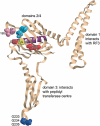Novel Escherichia coli RF1 mutants with decreased translation termination activity and increased sensitivity to the cytotoxic effect of the bacterial toxins Kid and RelE
- PMID: 19019162
- PMCID: PMC2680264
- DOI: 10.1111/j.1365-2958.2008.06510.x
Novel Escherichia coli RF1 mutants with decreased translation termination activity and increased sensitivity to the cytotoxic effect of the bacterial toxins Kid and RelE
Abstract
Novel mutations in prfA, the gene for the polypeptide release factor RF1 of Escherichia coli, were isolated using a positive genetic screen based on the parD (kis, kid) toxin-antitoxin system. This original approach allowed the direct selection of mutants with altered translational termination efficiency at UAG codons. The isolated prfA mutants displayed a approximately 10-fold decrease in UAG termination efficiency with no significant changes in RF1 stability in vivo. All three mutations, G121S, G301S and R303H, were situated close to the nonsense codon recognition site in RF1:ribosome complexes. The prfA mutants displayed increased sensitivity to the RelE toxin encoded by the relBE system of E. coli, thus providing in vivo support for the functional interaction between RF1 and RelE. The prfA mutants also showed increased sensitivity to the Kid toxin. Since this toxin can cleave RNA in a ribosome-independent manner, this result was not anticipated and provided first evidence for the involvement of RF1 in the pathway of Kid toxicity. The sensitivity of the prfA mutants to RelE and Kid was restored to normal levels upon overproduction of the wild-type RF1 protein. We discuss these results and their utility for the design of novel antibacterial strategies in the light of the recently reported structure of ribosome-bound RF1.
Figures








Similar articles
-
Functional interaction between release factor one and P-site peptidyl-tRNA on the ribosome.J Mol Biol. 1996 Aug 16;261(2):98-107. doi: 10.1006/jmbi.1996.0444. J Mol Biol. 1996. PMID: 8757279
-
Mechanism of premature translation termination on a sense codon.J Biol Chem. 2018 Aug 10;293(32):12472-12479. doi: 10.1074/jbc.AW118.003232. Epub 2018 Jun 25. J Biol Chem. 2018. PMID: 29941456 Free PMC article.
-
Thermodynamic and kinetic insights into stop codon recognition by release factor 1.PLoS One. 2014 Apr 3;9(4):e94058. doi: 10.1371/journal.pone.0094058. eCollection 2014. PLoS One. 2014. PMID: 24699820 Free PMC article.
-
Structure and function of bacterial kid-kis and related toxin-antitoxin systems.Protein Pept Lett. 2007;14(2):113-24. doi: 10.2174/092986607779816096. Protein Pept Lett. 2007. PMID: 17305597 Review.
-
Ribosomal RNAs in translation termination: facts and hypotheses.Biochemistry (Mosc). 1999 Dec;64(12):1354-9. Biochemistry (Mosc). 1999. PMID: 10648958 Review.
Cited by
-
Ecology and evolution as targets: the need for novel eco-evo drugs and strategies to fight antibiotic resistance.Antimicrob Agents Chemother. 2011 Aug;55(8):3649-60. doi: 10.1128/AAC.00013-11. Epub 2011 May 16. Antimicrob Agents Chemother. 2011. PMID: 21576439 Free PMC article. Review.
-
A Short-Term View of Protein Sequence Evolution from Salmonella.Genome Biol Evol. 2025 Mar 6;17(3):evaf040. doi: 10.1093/gbe/evaf040. Genome Biol Evol. 2025. PMID: 40048608 Free PMC article.
-
Enabling stop codon read-through translation in bacteria as a probe for amyloid aggregation.Sci Rep. 2017 Sep 19;7(1):11908. doi: 10.1038/s41598-017-12174-0. Sci Rep. 2017. PMID: 28928456 Free PMC article.
-
Development of a high yielding expression platform for the introduction of non-natural amino acids in protein sequences.MAbs. 2020 Jan-Dec;12(1):1684749. doi: 10.1080/19420862.2019.1684749. MAbs. 2020. PMID: 31775561 Free PMC article.
References
-
- Bernard P, Couturier M. Cell killing by the F plasmid CcdB protein involves poisoning of DNA–topoisomerase II complexes. J Mol Biol. 1992;226:735–745. - PubMed
-
- Bravo A, Ortega S, de Torrontegui G, Diaz R. Killing of Escherichia coli cells modulated by components of the stability system ParD of plasmid R1. Mol Gen Genet. 1988;215:146–151. - PubMed
Publication types
MeSH terms
Substances
LinkOut - more resources
Full Text Sources
Other Literature Sources
Molecular Biology Databases

